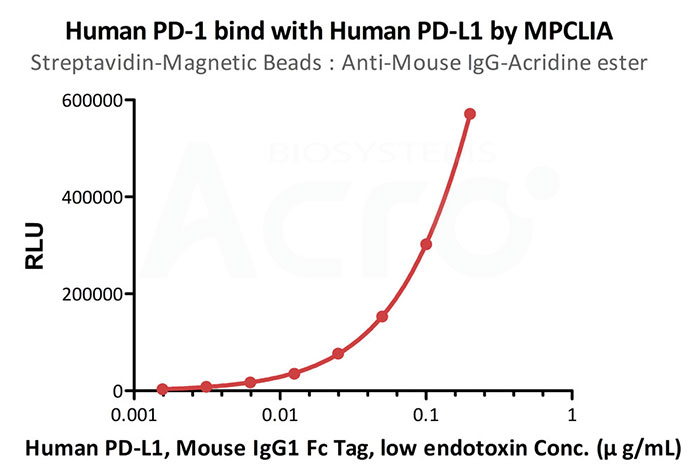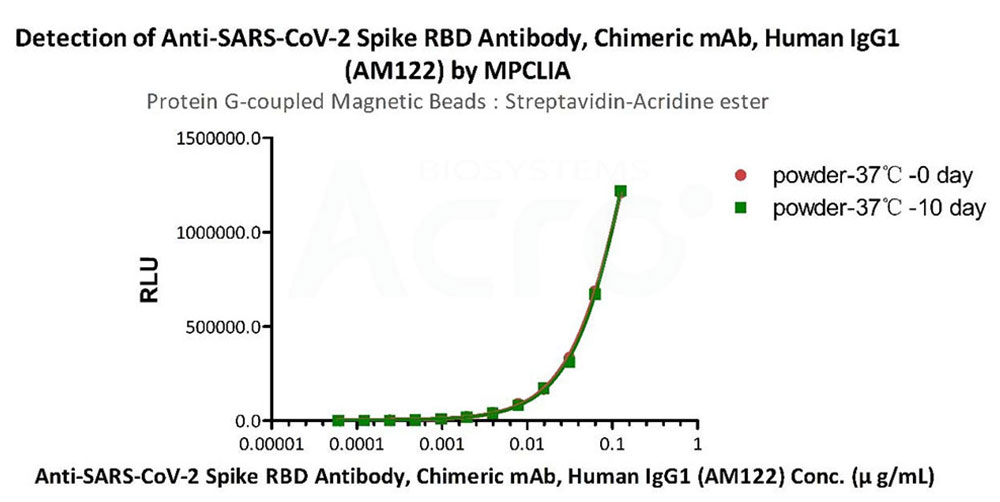 Limited Edition Golden Llama is here! Check out how you can get one.
Limited Edition Golden Llama is here! Check out how you can get one.  Limited Edition Golden Llama is here! Check out how you can get one.
Limited Edition Golden Llama is here! Check out how you can get one.
 Offering SPR-BLI Services - Proteins provided for free!
Offering SPR-BLI Services - Proteins provided for free! Get your ComboX free sample to test now!
Get your ComboX free sample to test now!
 Time Limited Offer: Welcome Gift for New Customers !
Time Limited Offer: Welcome Gift for New Customers !  Shipping Price Reduction for EU Regions
Shipping Price Reduction for EU Regions
> Reagenzien zur Erstellung von eigenen Magnetpartikel-Chemilumineszenz-Immunoassays (MPCLIA)

Der Magnetpartikel (MP)-Chemilumineszenz-Immunoassay (CLIA) mit ist eine Analysemethode, die die Flexibilität von magnetischen Beads mit der Empfindlichkeit und Spezifität von CLIA kombiniert. Anstelle der Immobilisierung von Proteinen oder Antikörpern in der Well-Platte bieten magnetische Beads eine erhebliche Vergrößerung der Probenkontaktfläche, der Erfassungseffizienz und der Automatisierungsmöglichkeiten. MPCLIA wird daher immer häufiger in der Krankheitsdiagnostik, der Überwachung chemischer Reaktionen und in vielen anderen Forschungsbereichen eingesetzt.
Neben der Verwendung von magnetischen Beads als Grundgerüst besteht der größte Unterschied zwischen MPCLIA und herkömmlichen ELISA in der Chemilumineszenz als Nachweismethode. Durch eine chemische Reaktion, bei der Substanzen wie Meerrettichperoxidase (HRP) und Acridiniumester (AE) angeregt werden, werden Photonen freigesetzt, die mit einem speziellen Chemilumineszenz-Lesegerät gemessen werden können. Im Vergleich dazu haben CLIA-Methoden oft eine höhere Empfindlichkeit, Spezifität und lineare Bereiche über herkömmliche ELISA-Methoden hinaus.
Chemiluminescence Detection Mechanism

Colorimetric (ELISA) Detection Mechanism

| Produkttyp | Kat. Nr. | Produktbeschreibung | Vorbestellung/Bestellung |
|---|

| Assay-Nr. | Magnetische Beads | Probe 1 | Probe 2 | Markierung | Substratlösung |
|---|---|---|---|---|---|
| 1 | Protein A-coupled Magnetic Beads (Cat. No. MPC-A001) | Human Antibody | Biotinylated non-Fc tag protein | Streptavidin-Acridine ester (Cat. No. STN-NA114) | Substrate Solution(AE Marker) (Cat. No. ABK-001) |
| 2 | hFc tag protein | ||||
| 3 | Protein G-coupled Magnetic Beads (Cat. No. MPC-A002) | Human/Mouse Antibody | Biotinylated non-Fc tag protein | ||
| 4 | Fc tag protein | ||||
| 5 | Anti-His-coupled Magnetic Beads (Cat. No. MPC-A005) | His tag protein | Biotinylated non-His tag protein | ||
| 6 | Human antibody | Anti-Human IgG-Acridine ester (Cat. No. AHG-Y69) | |||
| 7 | hFc tag protein | ||||
| 8 | Anti-Mouse IgG-coupled Magnetic Beads (Cat. No. MPC-A003) | Mouse antibody | Biotinylated non-mFc tag protein | Streptavidin-Acridine ester (Cat. No. STN-NA114) | |
| 9 | mFc tag protein | ||||
| 10* | Mouse antibody | hFc tag protein | Anti-Human IgG-Acridine ester (Cat. No. AHG-Y69) | ||
| 11* | mFc tag protein | Human antibody | |||
| 12* | hFc tag protein | ||||
| 13 | Streptavidin-Magnetic Beads (recommended for MPCLIA) (Cat. No. MPC-A006) | Biotinylated non-hFc tag protein | Human antibody | ||
| 14 | hFc tag protein | ||||
| 15 | Biotinylated non-mFc tag protein | Mouse antibody | Anti-Mouse IgG-Acridine ester (Cat. No. AMG-S163) | ||
| 16 | mFc tag protein | ||||
| 17 | Anti-Human IgG-coupled Magnetic Beads (Cat. No. MPC-A004) | Human antibody | mFc tag protein | ||
| 18 | hFc tag protein | ||||
| 19* | hFc tag protein | Mouse antibody | |||
| 20* | Human antibody | Biotinylated non-hFc tag protein | Streptavidin-Acridine ester (Cat. No. STN-NA114) | ||
| 21* | hFc tag protein |

Immobilized 0.04 μg /Test of Biotinylated Human PD-1, Avitag,His Tag (recommended for biopanning) (Cat. No. PD1-H82E4) to the Streptavidin-Acridine ester (Cat. No. STN-NA114, 0.008 μg /Test), incubated with 100 μL /Test of Human PD-L1, Fc Tag (Cat. No. PD1-H5258) at increasing concentration coupled to Protein A-coupled Magnetic Beads (recommended for MPCLIA) (Cat. No. MPC-A001) (10 μg beads/Test). Detection was performed with sensitivity of 3.125 ng/mL in Magnetic Particle Chemiluminescence immunoassay (MPCLIA) (KEYSMILE, SMART 6500S) (QC tested).
| Cat. No. | Product Description |
|---|---|
| PD1-H82E4 | Biotinylated Human PD-1 / PDCD1 Protein, Avitag™,His Tag (recommended for biopanning) (MALS verified) |
| STN-NA114 | Streptavidin Protein-Acridine ester (MALS verified) |
| PD1-H5258 | Human PD-L1 / B7-H1 Protein, Fc Tag (MALS verified) |
| MPC-A001 | Protein A-coupled Magnetic Beads (recommended for MPCLIA) |

Immobilized 0.04 μg /Test of Biotinylated Human PD-1, Avitag,His Tag (recommended for biopanning) (Cat. No. PD1-H82E4) to the Streptavidin-Magnetic Beads (recommended for MPCLIA) (Cat. No. MPC-A006, 20 μg beads/Test), incubated with 100 μL /Test of Human PD-L1, Mouse IgG1 Fc Tag, low endotoxin (Cat. No. PD1-H52A3) at increasing concentration coupled to Anti-Mouse IgG-Acridine ester (Cat. No. AMG-S163, 0.04 μg /Test). Detection was performed with sensitivity of 1.5625 ng/mL in Magnetism particulate chemiluminescence immunoassay (MPCLIA) (KEYSMILE, SMART 6500S) (QC tested).
| Cat. No. | Product Description |
|---|---|
| PD1-H82E4 | Biotinylated Human PD-1 / PDCD1 Protein, Avitag™,His Tag (recommended for biopanning) (MALS verified) |
| MPC-A006 | Streptavidin-Magnetic Beads (recommended for MPCLIA) |
| PD1-H52A3 | Human PD-L1 / B7-H1 Protein, Mouse IgG1 Fc Tag, low endotoxin (MALS verified) |
| AMG-S163 | Anti-Mouse IgG-Acridine ester (MALS verified) |

Immobilized 0.04 μg /Test of Biotinylated Human PD-1 Protein, Avitag,His Tag (Cat. No. PD1-H82E4) to the Streptavidin-Magnetic Beads (recommended for MPCLIA) (Cat. No. MPC-A006, 20 μg beads/Test), incubated with 100 μL /Test of Human PD-L1, Fc Tag (Cat. No. PD1-H5258) at increasing concentration coupled to Anti-Human IgG Antibody-Acridine ester (Cat. No. AHG-Y69, 0.04 μg /Test). Detection was performed with sensitivity of 0.488 ng/mL in Magnetism particulate chemiluminescence immunoassay (MPCLIA) (KEYSMILE, SMART 6500S) (QC tested).

When used the Chemiluminescent Substrate Solution (AE Marker) (Cat. No. ABK-001) in a sandwich MPCLIA Assay for detection of SARS-CoV-2, The Biotinylated Anti-SARS-CoV-2 Nucleocapsid Antibody, Mouse IgG1 (Cat. No. NUN-BM266) coupled Streptavidin-Magnetic Beads (recommended for MPCLIA) (Cat. No. MPC-A006) was incubated with Acridine Ester-Labeled Anti-SARS-CoV-2 Nucleocapsid Antibody, Chimeric mAb, Human IgG1 (AM224) (Cat. No. NUN-M224) and treated with SARS-CoV-2 Nucleocapsid protein, His Tag (Cat. No. NUN-C5227) at increasing concentration, detection was performed using with sensitivity of 97.7 pg/mL in Magnetism particulate chemiluminescence immunoassay (MPCLIA) (KEYSMILE, SMART 6500S) (QC tested).

When used the Chemiluminescent Substrate Solution (HRP Marker) (Cat. No. ABK-002) in a sandwich CLEIA Assay for detection of Human IFN-gamma, immobilized Monoclonal Anti-IFNγ antibody, Human IgG1 at 2 μg/mL, add increasing concentrations of Human IFN-gamma, premium grade (Cat. No. IFG-H4211) and then add Biotinylated Biotinylated Monoclonal Anti-IFNγ antibody, Human IgG at 0.05 μg/mL. Detection was performed using Streptavidin-HRP, Horseradish peroxidase conjugated Streptavidin (Cat. No. STN-NH913) with sensitivity of 7.8 pg/mL.

Immobilized 0.04 μg /Test of Biotinylated Human PD-1, Avitag,His Tag (recommended for biopanning) (Cat. No. PD1-H82E4) to the Streptavidin-Acridine ester (Cat. No. STN-NA114, 0.008 μg /Test), incubated with 100 μL /Test of Human PD-L1, Fc Tag (Cat. No. PD1-H5258) at increasing concentration coupled to Protein A-coupled Magnetic Beads (recommended for MPCLIA) (Cat. No. MPC-A001) (10 μg beads/Test). Detection was performed with sensitivity of 3.125 ng/mL in Magnetism particulate chemiluminescence immunoassay (MPCLIA) (KEYSMILE, SMART 6500S) (QC tested).

The MPCLIA assay shows that Protein G-coupled Magnetic Beads (recommended for MPCLIA) (Cat. No. MPC-A002) is stable at 37°C for 10 days.

The MPCLIA assay shows that Anti-Human IgG-coupled Magnetic Beads (recommended for MPCLIA) (Cat. No. MPC-A004) is stable after freezing and thawing 3 times.

The MPCLIA assay shows that Anti-His Tag-coupled Magnetic Beads (recommended for MPCLIA) (Cat. No. MPC-A005) is stable at 37°C for 10 days.
This web search service is supported by Google Inc.
